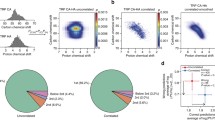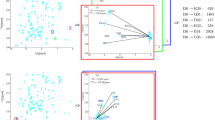Abstract
Stereo-array isotope labeling (SAIL) has been combined with the fully automated NMR structure determination algorithm FLYA to determine the three-dimensional structure of the protein ubiquitin from different sets of input NMR spectra. SAIL provides a complete stereo- and regio-specific pattern of stable isotopes that results in sharper resonance lines and reduced signal overlap, without information loss. Here we show that as a result of the superior quality of the SAIL NMR spectra, reliable, fully automated analyses of the NMR spectra and structure calculations are possible using fewer input spectra than with conventional uniformly 13C/15N-labeled proteins. FLYA calculations with SAIL ubiquitin, using a single three-dimensional “through-bond” spectrum (and 2D HSQC spectra) in addition to the 13C-edited and 15N-edited NOESY spectra for conformational restraints, yielded structures with an accuracy of 0.83–1.15 Å for the backbone RMSD to the conventionally determined solution structure of SAIL ubiquitin. NMR structures can thus be determined almost exclusively from the NOESY spectra that yield the conformational restraints, without the need to record many spectra only for determining intermediate, auxiliary data of the chemical shift assignments. The FLYA calculations for this report resulted in 252 ubiquitin structure bundles, obtained with different input data but identical structure calculation and refinement methods. These structures cover the entire range from highly accurate structures to seriously, but not trivially, wrong structures, and thus constitute a valuable database for the substantiation of structure validation methods.



Similar content being viewed by others
References
Baran MC, Huang YJ, Moseley HNB, Montelione GT (2004) Automated analysis of protein NMR assignments and structures. Chem Rev 104:3541–3555
Bartels C, Billeter M, Güntert P, Wüthrich K (1996) Automated sequence-specific NMR assignment of homologous proteins using the program GARANT. J Biomol NMR 7:207–213
Bartels C, Güntert P, Billeter M, Wüthrich K (1997) GARANT—a general algorithm for resonance assignment of multidimensional nuclear magnetic resonance spectra. J Comput Chem 18:139–149
Billeter M, Wagner G, Wüthrich K (2008) Solution NMR structure determination of proteins revisited. J Biomol NMR 42:155–158
Bowie JU, Lüthy R, Eisenberg D (1991) A method to identify protein sequences that fold into a known 3-dimensional structure. Science 253:164–170
Brünger AT (1992) Free R value: a novel statistical quantity for assessing the accuracy of crystal structures. Nature 355:472–475
Cornell WD, Cieplak P, Bayly CI, Gould IR, Merz KM, Ferguson DM, Spellmeyer DC, Fox T, Caldwell JW, Kollman PA (1995) A second generation force field for the simulation of proteins, nucleic acids, and organic molecules. J Am Chem Soc 117:5179–5197
Cornilescu G, Delaglio F, Bax A (1999) Protein backbone angle restraints from searching a database for chemical shift and sequence homology. J Biomol NMR 13:289–302
Delaglio F, Grzesiek S, Vuister GW, Zhu G, Pfeifer J, Bax A (1995) NMRPipe—a multidimensional spectral processing system based on Unix pipes. J Biomol NMR 6:277–293
Gronwald W, Kalbitzer HR (2004) Automated structure determination of proteins by NMR spectroscopy. Prog Nucl Magn Reson Spectrosc 44:33–96
Güntert P (2003) Automated NMR protein structure calculation. Prog Nucl Magn Reson Spectrosc 43:105–125
Güntert P (2009) Automated structure determination from NMR spectra. Eur Biophys J 38:129–143
Güntert P, Mumenthaler C, Wüthrich K (1997) Torsion angle dynamics for NMR structure calculation with the new program DYANA. J Mol Biol 273:283–298
Herrmann T, Güntert P, Wüthrich K (2002) Protein NMR structure determination with automated NOE assignment using the new software CANDID and the torsion angle dynamics algorithm DYANA. J Mol Biol 319:209–227
Hiller S, Fiorito F, Wüthrich K, Wider G (2005) Automated projection spectroscopy (APSY). Proc Natl Acad Sci USA 102:10876–10881
Hooft RWW, Vriend G, Sander C, Abola EE (1996) Errors in protein structures. Nature 381:272
Ikeya T, Terauchi T, Güntert P, Kainosho M (2006) Evaluation of stereo-array isotope labeling (SAIL) patterns for automated structural analysis of proteins with CYANA. Magn Reson Chem 44:S152–S157
Johnson BA (2004) Using NMRView to visualize and analyze the NMR spectra of macromolecules. Meth Mol Biol 278:313–352
Johnson BA, Blevins RA (1994) NMR view—a computer program for the visualization and analysis of NMR data. J Biomol NMR 4:603–614
Kainosho M, Torizawa T, Iwashita Y, Terauchi T, Ono AM, Güntert P (2006) Optimal isotope labelling for NMR protein structure determinations. Nature 440:52–57
Koradi R, Billeter M, Wüthrich K (1996) MOLMOL: a program for display and analysis of macromolecular structures. J Mol Graph 14:51–55
Koradi R, Billeter M, Güntert P (2000) Point-centered domain decomposition for parallel molecular dynamics simulation. Comput Phys Commun 124:139–147
Kraulis PJ (1989) ANSIG: a program for the assignment of protein 1H 2D NMR spectra by interactive computer graphics. J Magn Reson 84:627–633
Kraulis PJ, Domaille PJ, Campbell-Burk SL, Van Aken T, Laue ED (1994) Solution structure and dynamics of Ras p21-GDP determined by heteronuclear three- and four-dimensional NMR spectroscopy. Biochemistry 33:3515–3531
Kupče E, Freeman R (2008) Hyperdimensional NMR spectroscopy. Prog Nucl Magn Reson Spectrosc 52:22–30
Laskowski RA, Rullmann JAC, MacArthur MW, Kaptein R, Thornton JM (1996) AQUA and PROCHECK-NMR: programs for checking the quality of protein structures solved by NMR. J Biomol NMR 8:477–486
Linge JP, O’Donoghue SI, Nilges M (2001) Automated assignment of ambiguous nuclear overhauser effects with ARIA. Methods Enzymol 339:71–90
López-Méndez B, Güntert P (2006) Automated protein structure determination from NMR spectra. J Am Chem Soc 128:13112–13122
Luan T, Jaravine V, Yee A, Arrowsmith CH, Orekhov VY (2005) Optimization of resolution and sensitivity of 4D NOESY using multi-dimensional decomposition. J Biomol NMR 33:1–14
Luginbühl P, Güntert P, Billeter M, Wüthrich K (1996) The new program OPAL for molecular dynamics simulations and energy refinements of biological macromolecules. J Biomol NMR 8:136–146
Lüthy R, Bowie JU, Eisenberg D (1992) Assessment of protein models with 3-dimensional profiles. Nature 356:83–85
Malmodin D, Billeter M (2005) High-throughput analysis of protein NMR spectra. Prog Nucl Magn Reson Spectrosc 46:109–129
Malmodin D, Papavoine CHM, Billeter M (2003) Fully automated sequence-specific resonance assignments of heteronuclear protein spectra. J Biomol NMR 27:69–79
Morris AL, Macarthur MW, Hutchinson EG, Thornton JM (1992) Stereochemical quality of protein structure coordinates. Proteins 12:345–364
Nabuurs SB, Spronk CAEM, Vuister GW, Vriend G (2006) Traditional biomolecular structure determination by NMR spectroscopy allows for major errors. PLoS Comput Biol 2:71–79
Pfändler P, Bodenhausen G, Meier BU, Ernst RR (1985) Toward automated assignment of nuclear magnetic resonance spectra—pattern recognition in two-dimensional correlation spectra. Anal Chem 57:2510–2516
Ponder JW, Case DA (2003) Force fields for protein simulations. Adv Protein Chem 66:27–85
Sakakibara D, Sasaki A, Ikeya T, Hamatsu J, Hanashima T, Mishima M, Yoshimasu M, Hayashi N, Mikawa T, Wälchli M, Smith BO, Shirakawa M, Güntert P, Ito Y (2009) Protein structure determination in living cells by in-cell NMR spectroscopy. Nature 458:102–105
Schultze P, Feigon J (1997) Chirality errors in nucleic acid structures. Nature 387:668
Scott A, López-Méndez B, Güntert P (2006) Fully automated structure determinations of the Fes SH2 domain using different sets of NMR spectra. Magn Reson Chem 44:S83–S88
Sippl MJ (1993) Recognition of errors in 3-dimensional structures of proteins. Proteins 17:355–362
Spronk C, Nabuurs SB, Krieger E, Vriend G, Vuister GW (2004) Validation of protein structures derived by NMR spectroscopy. Prog Nucl Magn Reson Spectrosc 45:315–337
Szyperski T, Atreya HS (2006) Principles and applications of GFT projection NMR spectroscopy. Magn Reson Chem 44:S51–S60
Takeda M, Ikeya T, Güntert P, Kainosho M (2007) Automated structure determination of proteins with the SAIL-FLYA NMR method. Nat Protoc 2:2896–2902
Takeda M, Sugimori N, Torizawa T, Terauchi T, Ono AM, Yagi H, Yamaguchi Y, Kato K, Ikeya T, Jee J, Güntert P, Aceti DJ, Markley JL, Kainosho M (2008) Structure of the putative 32 kDa myrosinase-binding protein from Arabidopsis (At3g16450.1) determined by SAIL-NMR. FEBS J 275:5873–5884
Terauchi T, Kobayashi K, Okuma K, Oba M, Nishiyama K, Kainosho M (2008) Stereoselective synthesis of triply isotope-labeled Ser, Cys, and Ala: amino acids for stereoarray isotope labeling technology. Org Lett 10:2785–2787
Torizawa T, Shimizu M, Taoka M, Miyano H, Kainosho M (2004) Efficient production of isotopically labeled proteins by cell-free synthesis: a practical protocol. J Biomol NMR 30:311–325
Torizawa T, Ono AM, Terauchi T, Kainosho M (2005) NMR assignment methods for the aromatic ring resonances of phenylalanine and tyrosine residues in proteins. J Am Chem Soc 127:12620–12626
Wallner B, Elofsson A (2003) Can correct protein models be identified? Protein Sci 12:1073–1086
Williamson MP, Craven CJ (2009) Automated protein structure calculation from NMR data. J Biomol NMR 43:131–143
Wüthrich K (1986) NMR of proteins and nucleic acids. Wiley, New York
Acknowledgments
We thank Dr. Akira Mei Ono for help in preparing the SAIL amino acids. We gratefully acknowledge financial support by a Grant-in-Aid for Scientific Research of the Japan Society for the Promotion of Science (JSPS), and from the CREST program of the Japan Science and Technology Agency (JST), the Technology Development for Protein Analyses and Targeted Protein Research Program of the Ministry of Education, Culture, Sports, Science and Technology of Japan, and the Lichtenberg program of the Volkswagen Foundation.
Author information
Authors and Affiliations
Corresponding authors
Rights and permissions
About this article
Cite this article
Ikeya, T., Takeda, M., Yoshida, H. et al. Automated NMR structure determination of stereo-array isotope labeled ubiquitin from minimal sets of spectra using the SAIL-FLYA system. J Biomol NMR 44, 261–272 (2009). https://doi.org/10.1007/s10858-009-9339-6
Received:
Accepted:
Published:
Issue Date:
DOI: https://doi.org/10.1007/s10858-009-9339-6




